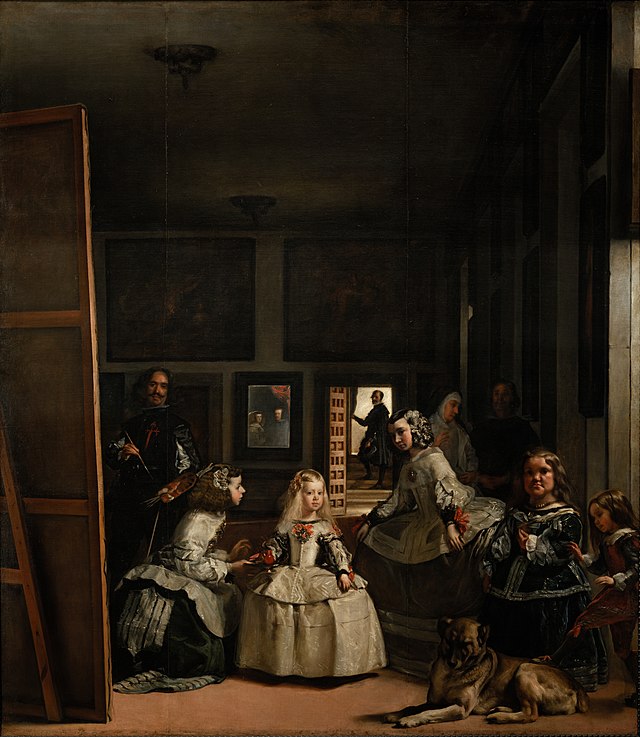Table of Contents
The Masterful Art of Diego Velázquez: A Unique Drawing Style that Shaped Baroque Painting
Diego Rodríguez de Silva y Velázquez, commonly known as Diego Velázquez, stands as one of the most celebrated artists in Western art history. Born in Seville in 1599, Velázquez’s work is a testament to the rich cultural and artistic heritage of the Spanish Baroque period. His unique drawing style and masterful techniques have influenced countless artists and continue to captivate art enthusiasts worldwide.

Las Meninas, by Diego Velázquez, from Prado in Google Earth (photo by Wikimedia Commons)
A Glimpse into Velázquez’s Life and Influences
Velázquez was born into a time of cultural flourishing in Spain. The Counter-Reformation was in full swing, and the Spanish monarchy was a significant patron of the arts. Velázquez’s early training under Francisco Pacheco, a well-regarded painter and theorist, laid a strong foundation for his future works. Pacheco’s influence is evident in Velázquez’s early religious paintings, which are characterized by meticulous attention to detail and a deep understanding of human anatomy.
However, Velázquez’s style evolved significantly after he moved to Madrid and became the court painter to King Philip IV of Spain. Here, he was exposed to the works of the Italian Renaissance and the innovations of contemporary artists like Caravaggio. This exposure broadened his artistic horizons and led to the development of his distinctive style.
The Unique Drawing Style of Velázquez
Velázquez’s drawing style is often described as both realistic and impressionistic—a paradox that highlights his genius. Unlike many of his contemporaries, who favored precise lines and clear contours, Velázquez employed a looser, more fluid approach to drawing. This technique allowed him to capture the essence of his subjects with an unparalleled sense of immediacy and life.
- Mastery of Light and Shadow: One of the most defining features of Velázquez’s style is his sophisticated use of chiaroscuro—the contrast between light and shadow. He used this technique not only to create depth but also to convey mood and atmosphere. In his famous painting “Las Meninas,” the interplay of light and shadow draws the viewer into the scene, making them feel like a part of the royal court.
- Loose Brushwork: Velázquez’s brushwork was revolutionary for his time. He often applied paint in swift, confident strokes, which, when viewed up close, might appear almost abstract. However, when seen from a distance, these strokes coalesce into remarkably lifelike images. This technique is particularly evident in his portraits, where the texture of the skin, the sheen of fabric, and the glint of metal are all rendered with seemingly effortless precision.
- Psychological Depth: Another hallmark of Velázquez’s drawing style is the psychological depth he imparts to his subjects. His portraits go beyond mere physical likeness; they capture the inner lives of his sitters. In “Portrait of Pope Innocent X,” for example, Velázquez masterfully conveys the pope’s authority and gravitas, as well as a hint of vulnerability, through subtle nuances in expression and posture.
- Naturalism and Realism: Velázquez was a pioneer of naturalism, rejecting the idealization common in the art of his time. His works are characterized by a commitment to portraying the world as it is, without embellishment. This is evident in his depiction of the Spanish court, where he portrayed royalty and commoners with the same level of honesty and humanity.
Iconic Works that Showcase Velázquez’s Style
Several of Velázquez’s masterpieces encapsulate the essence of his unique drawing style:
- “Las Meninas” (1656): Often hailed as Velázquez’s magnum opus, this complex and enigmatic painting showcases his mastery of perspective, light, and composition. The loose brushwork and the interaction of the figures within the space create a dynamic, almost cinematic, scene.
- “The Surrender of Breda” (1634–1635): This historical painting demonstrates Velázquez’s ability to depict large groups of people with individuality and realism. The drawing style emphasizes the tension and emotion of the moment while maintaining a sense of dignity and respect for both the victors and the vanquished.
- “Portrait of Juan de Pareja” (1650): This portrait is a striking example of Velázquez’s skill in capturing the character and dignity of his subjects. The loose yet precise brushwork highlights the sitter’s features with incredible realism and depth.
Velázquez’s Legacy in Art History
Diego Velázquez’s unique drawing style has had a profound impact on the course of Western art. His ability to blend realism with an almost impressionistic approach to brushwork paved the way for future generations of artists, including the Impressionists. Edouard Manet, in particular, was a great admirer of Velázquez, often citing him as a direct influence on his own work.
Moreover, Velázquez’s approach to portraiture—wherein the psychological and emotional state of the subject is as important as their physical appearance—has become a standard in the genre. His works continue to be studied for their innovative techniques and their deep, humanistic approach to art.
So…
Diego Velázquez remains a towering figure in the history of art. His unique drawing style, characterized by mastery of light, loose brushwork, psychological depth, and unwavering realism, continues to inspire and influence artists and art lovers alike. Velázquez’s works are not just paintings; they are profound explorations of the human experience, captured with an artistry that transcends time.


No responses yet